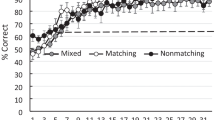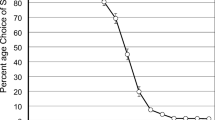Abstract
In a conditional discrimination (matching-to-sample), a sample is followed by two comparison stimuli, one of which is correct, depending on the sample. Evidence from previous research suggests that if the stimulus display is maintained following an incorrect response (the so-called penalty-time procedure), acquisition by pigeons is facilitated. The present research tested the hypothesis that the penalty-time procedure allows the pigeons to review and learn from the maintained stimulus display following an incorrect choice. It did so by including a penalty-time group for which, following an incorrect choice, the sample changed to match the incorrect comparison, thus providing the pigeons with post-choice ‘misinformation.’ This misinformation group acquired the matching task significantly slower than the standard penalty-time group (that had no change in the sample following an error). Furthermore, acquisition of matching by a control group that received no penalty time fell midway between the other two groups, suggesting that the pigeons did not merely take more care in making choices because of the aversiveness of penalty-time. Thus, it appears that in the acquisition of matching-to-sample, when the stimulus display is maintained following an incorrect choice, the pigeons can review or acquire information from the display. This is the first time that such an effect has been reported for a nonhuman species.



Similar content being viewed by others
References
Bourne LE Jr, Guy DE, Dodd DE, Justesen DR (1965) Concept identification: the effect of varying length and informational components of the intertrial interval. J Exp Psychol 69:624–629
Clement TS, Zentall TR (2000) Development of a single-code/default coding strategy in pigeons. Psychol Sci 11:261–264
Estes WK (1972) Reinforcement in human behavior. Am Sci 60:723–729
Halff HM (1975) Stimulus presentation after successes and errors in concept identification. Am J Psychol 88:421–430
Hogan DE, Zentall TR (1977) Backward associative learning in the pigeon. Am J Psychol 90:3–15
Peterson GB (1984) How expectancies guide behavior. In Roitblat HL, Bever TG, Terrace HS (eds) Animal cognition. Erlbaum, Hillsdale, N.J., pp 135–148
Richards RW (1988) The question of bidirectional associations in pigeons’ learning of conditional discrimination tasks. Bull Psychon Soc 26:577–579
Riley DA, Roitblat HL (1978) Selective attention and related cognitive processes in pigeons. In: Hulse SH, Fowler H, Honig WK (eds) Cognitive processes in animal behavior. Erlbaum, Hillsdale, N.J., pp 249–276
Roberts WA (1972) Short-term memory in the pigeon: effects of repetition and spacing. J Exp Psychol 94:74–83
Rodewald HK (1974) Symbolic matching-to-sample by pigeons. Psychol Rep 34:987–990
Sherburne LM, Zentall TR (1995) Delayed matching in pigeons with food and no-food samples: further examination of backward associations. Anim Learn Behav 23:177–181
Spetch ML, Wilkie DM, Pinel JPJ (1981) Backward conditioning: A reevaluation of the empirical evidence. Psychol Bull 89:163–175
Strength V, Zentall TR (1991) Matching and oddity learning in pigeons: effects of penalty time for incorrect responding. Anim Learn Behav 19:49–57
Trapold MA (1970) Are expectancies based on different positive reinforcing events discriminably different? Learn Motiv 1:129–140
Zentall TR (2000) Symbolic representation by pigeons. Curr Dir Psychol Sci 9:118–123
Zentall TR, Hogan DE (1976) Pigeons can learn identity, difference, or both. Science 191:408–409
Zentall TR, Sherburne LM, Steirn JN (1992) Development of excitatory backward associations during the establishment of forward associations in a delayed conditional discrimination by pigeons. Anim Learn Behav 20:199–206
Acknowledgements
This research was supported by National Institute of Mental Health Grant MH-63726 to the second author. Tracy I. Martin is now at the Department of Animal Science, Texas A & M University
Author information
Authors and Affiliations
Corresponding author
Rights and permissions
About this article
Cite this article
Martin, T.I., Zentall, T.R. Post-choice information processing by pigeons. Anim Cogn 8, 273–278 (2005). https://doi.org/10.1007/s10071-005-0254-2
Received:
Revised:
Accepted:
Published:
Issue Date:
DOI: https://doi.org/10.1007/s10071-005-0254-2




